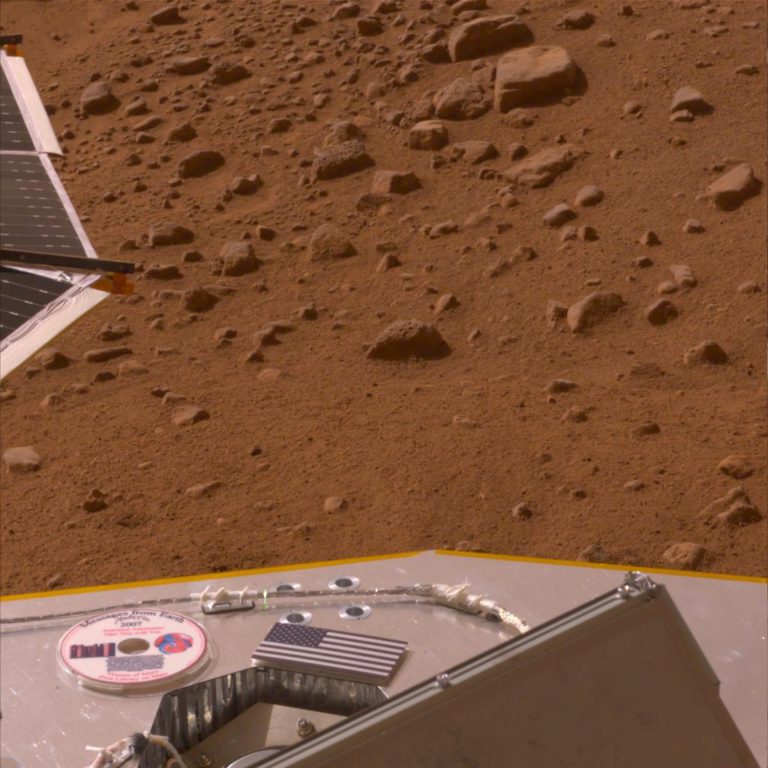Visions of Mars
Visions of Mars is a digital time capsule placed on mars for its future human inhabitants. Developed and funded by The Planetary Society, it arrived at the Red Planet on 25 May 2008 onboard NASA's Phoenix lander. Along with personal messages from leading space visionaries of our time, Visions of Mars included a priceless collection of Mars literature, and art, and a list of hundreds of thousands of names of space enthusiasts from around the world. The entire collection was encoded on an archival silica-glass mini-DVD designed to last hundreds—if not thousands—of years.
Imagine: it could be centuries from now, on the planet Mars, when a man, or a woman, or perhaps a child, will come across this small disk. This person may be encased in an elaborate spacesuit, or perhaps breathing freely in the newly oxygenated atmosphere of the former Red Planet. The surrounding landscape might be that of a harsh red desert, as it is today, or it might be green rolling hills, the result of intense terra-forming. We do not know. All we know is that when this future Martian picks up this tame-looking disk, he or she will hold in their hands a message from our world, addressed to theirs.

The disk will be part of a relic of an ancient robotic spacecraft named Phoenix, which landed on the planet in 2008. Possibly preserved as a historic memento, perhaps long abandoned and forgotten, Phoenix will have kept its secret through the long Martian years. But now, at last, its time had come and its message is set to be revealed. The ancient digital format of the small disk may pose a problem, but surely not an insurmountable one for these technologically advanced pioneers. Soon the images will appear on their screens, bearing greetings from visionaries of a distant time, on a distant world.
There is Carl Sagan, speaking to the future Martians from near his home in Ithaca, New York, with a waterfall cascading in the background. There is Arthur Clarke, seated in the comfort of his home in tropical Sri Lanka. The Planetary Society's Louis Friedman speaks to them from the Society's headquarters in Pasadena, California, and science fiction author and editor Judith Merrill of Canada also sends her greetings. A wealth of additional content appears on the disk, which was carefully assembled and edited under the direction of Planetary Society Advisor Jon Lomberg.
Many of these works have helped shape the human imaginings of our planetary neighbor. Giovanni Schiaparelli describes his observations of the famous "canali," which he believed crisscrossed the surface of Mars. Percival Lowell, in beautiful poetic prose, expounds his interpretation of these supposed "Mars canals," which formed popular and literary conceptions of the Red Planet for half a century. Lowell believed that the canals were an elaborate planet-wide irrigation system, engineered by technologically advanced Martians to combat the drying up of their planet. There is H.G. Wells, whose War of the Worlds imagined what such desperate and intelligent creatures might do to our own water-rich home. And there is Orson Welles' 1938 radio broadcast of this classic tale, which set off a wave of panic across the United States. The soundscape "The Winds of Mars" by composer Bob Derkach introduces Visions of Mars and closes the radio broadcasts on the disk.
E.R. Burroughs, of Tarzan fame, paid no attention to scientific considerations in his early 20th century Mars novels, which are also represented on the disk. Nevertheless, the immense popularity of his tales of high adventure taught millions to think of Mars as a place to go to, a possible setting for human action. His successors, Isaac Asimov, Ray Bradbury, Poul Anderson, and Arthur Clarke expanded on Wells' and Burroughs' images with scientifically informed and culturally sophisticated visions of a possible Martian future. They, and many others included in the disk, form a rich and nuanced tapestry of what the Red Planet has meant to humans at the end of the second millennium. Simply put, this modest-looking disk is a digital record of our collective dream of Mars.
From Lowell's benign Martians to Wells's vicious aliens; from supposed seasonal changes in vegetation to the harsh and lifeless desert revealed to the Viking landers; from Schiaparelli's "canali" to the washbasins observed by the Mars Global Surveyor; the simple-looking disk presents the very different planets called "Mars," which prevailed in human minds in the 20th century. Some are visions purely imaginary, others represent our fears and dreams for our own world, others yet are composed of hard scientific data. For all, the Red Planet is a place of wonder and aspiration, where one day humans will tread. What better gift to those pioneers of the future, who in their lives will fulfill the dreams of an earlier age.
Introduction to Visions of Mars
Peter H. Smith of the University of Arizona, Principal Investigator of the Phoenix mission, shares his thoughts on Visions of Mars, our message to the future settlers of the Red Planet.
Visions of Mars: Then and Now
Jon Lomberg, Director of the original Visions of Mars project, reflects on its cultural and historical significance.
Visions of Mars: The Stories
Our Visions of Mars disc aboard the Phoenix spacecraft includes 80 stories and articles by leading writers and scientists.
Visions of Mars: Artwork and Radio Broadcasts
The Visions of Mars mini-DVD landed on Mars onboard the spacecraft Phoenix. These are the contents of Visions of Mars.
Visions of Mars Credits, 2007
Who did what to make Visions of Mars a reality.


 Explore Worlds
Explore Worlds Find Life
Find Life Defend Earth
Defend Earth





